CMSI China Maritime Report #1: “China’s Third Sea Force, The People’s Armed Forces Maritime Militia: Tethered to the PLA”
Conor M. Kennedy and Andrew S. Erickson, China’s Third Sea Force, The People’s Armed Forces Maritime Militia: Tethered to the PLA, China Maritime Report 1 (Newport, RI: Naval War College China Maritime Studies Institute, March 2017).
Amid growing awareness that China’s Maritime Militia acts as a Third Sea Force which has been involved in international sea incidents, it is necessary for decision-makers who may face such contingencies to understand the Maritime Militia’s role in China’s armed forces. Chinese-language open sources reveal a tremendous amount about Maritime Militia activities, both in coordination with and independent of the People’s Liberation Army (PLA). Using well-documented evidence from the authors’ extensive open source research, this report seeks to clarify the Maritime Militia’s exact identity, organization, and connection to the PLA as a reserve force that plays a parallel and supporting role to the PLA. Despite being a separate component of China’s People’s Armed Forces (PAF), the militia are organized and commanded directly by the PLA’s local military commands. The militia’s status as a separate non-PLA force whose units act as “helpers of the PLA” (解放军的 助手) is further reflected in China’s practice of carrying out “joint military, law enforcement, and civilian [Navy-Maritime Law Enforcement-Maritime Militia] defense” (军警民联防). To more accurately capture the identity of the Maritime Militia, the authors propose referring to these irregular forces as the “People’s Armed Forces Maritime Militia” (PAFMM).
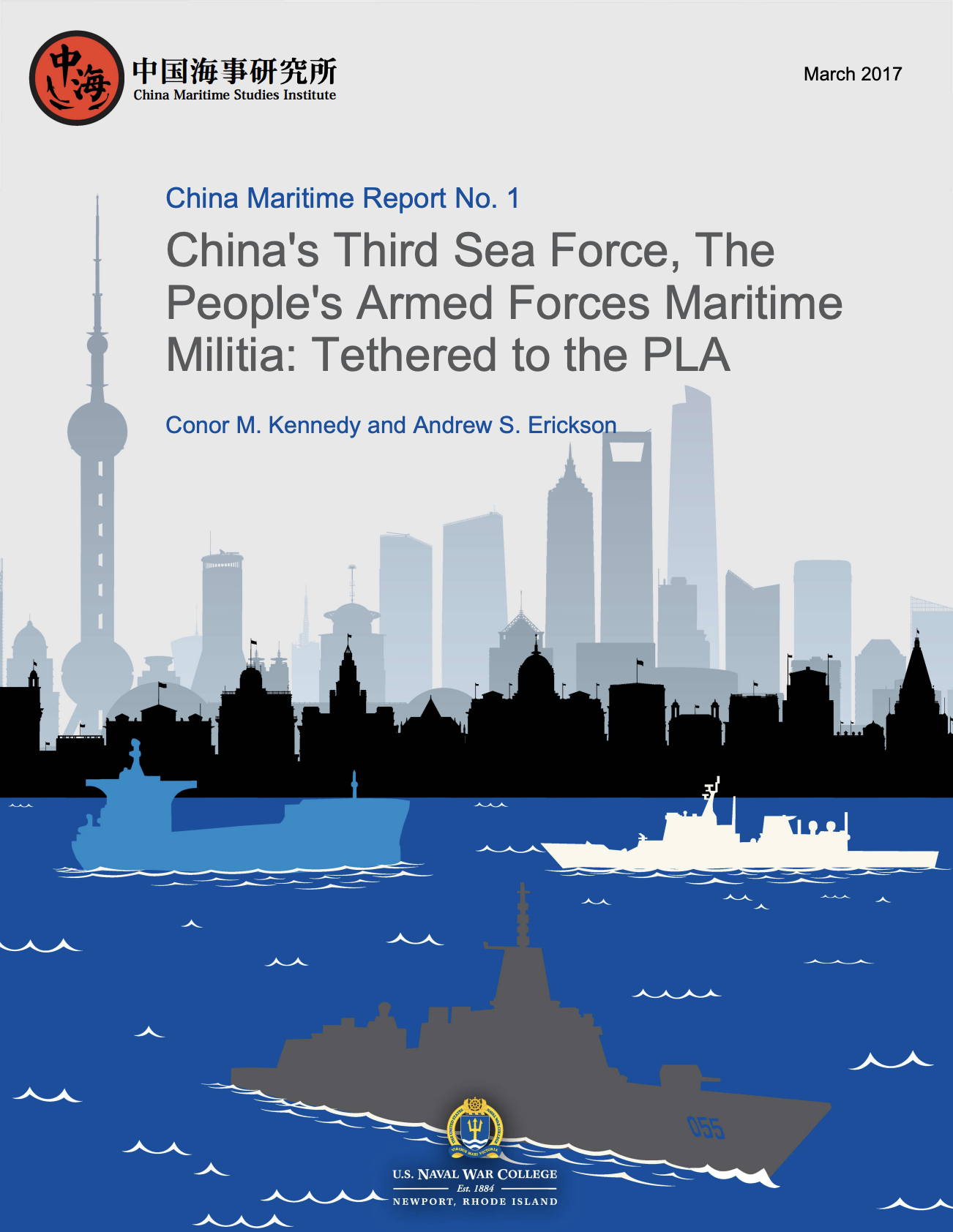
Conor M. Kennedy and Andrew S. Erickson, China’s Third Sea Force, The People’s Armed Forces Maritime Militia: Tethered to the PLA, China Maritime Report 1 (Newport, RI: Naval War College China Maritime Studies Institute, March 2017).
COVER
China, China Maritime Studies Institute, CMSI, People’s Armed Forces Maritime Militia, China Maritime Militia, PLA
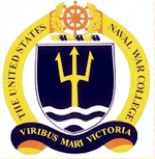

China’s Third Sea Force,
The People’s Armed Forces Maritime Militia:
Tethered to the PLA
Conor M. Kennedy and Andrew S. Erickson[1]
China Maritime Report No. 1
March 2017
China Maritime Studies Institute
U.S. Naval War College
Newport, Rhode Island
Summary
Amid growing awareness that China’s Maritime Militia acts as a Third Sea Force which has been involved in international sea incidents, it is necessary for decision-makers who may face such contingencies to understand the Maritime Militia’s role in China’s armed forces. Chinese-language open sources reveal a tremendous amount about Maritime Militia activities, both in coordination with and independent of the People’s Liberation Army (PLA). Using well-documented evidence from the authors’ extensive open source research, this report seeks to clarify the Maritime Militia’s exact identity, organization, and connection to the PLA as a reserve force that plays a parallel and supporting role to the PLA. Despite being a separate component of China’s People’s Armed Forces (PAF), the militia are organized and commanded directly by the PLA’s local military commands. The militia’s status as a separate non-PLA force whose units act as “helpers of the PLA” (解放军的助手)[2] is further reflected in China’s practice of carrying out “joint military, law enforcement, and civilian [Navy-Maritime Law Enforcement-Maritime Militia] defense” (军警民联防). To more accurately capture the identity of the Maritime Militia, the authors propose referring to these irregular forces as the “People’s Armed Forces Maritime Militia” (PAFMM).
Like a tetherball, the PAFMM may be sent in many different directions when contacted by different players in the Chinese security space, but is often directed by the PLA and always remains tied to the PLA.
Key points:
- Leading elements of China’s Maritime Militia have already played frontline roles in manifold Chinese incidents and skirmishes with foreign mariners throughout the South China Sea.
- The Militia is a key component of China’s Armed Forces and a part of what it calls the “People’s Armed Forces System” (人武系统).[3]
- China’s People’s Armed Forces Maritime Militia (PAFMM) is therefore the most accurate name for this Third Sea Force of China.
- Directed participation by PAFMM forces in international sea incidents or provocations occurs under the PLA chain of command, and sometimes also under the temporary command of the Chinese Maritime Law Enforcement (MLE).
- The PAFMM is thus a state-organized, -developed, and -controlled force operating under a direct military chain of command to conduct Chinese state-sponsored activities.
Command and Control
China boasts the world’s largest fishing fleet. A portion of its thousands of fishing vessels, and the thousands of people who work on them and in related industries, are registered in the Maritime Militia.[4] China’s PAFMM is an armed mass organization primarily comprising mariners working in the civilian economy who are trained and can be mobilized to defend and advance China’s maritime territorial claims, protect “maritime rights and interests,” and support the PLA Navy (PLAN) in wartime.
China’s People’s Armed Forces include the PLA, People’s Armed Police (PAP), and the militia, of which the PAF Maritime Militia (PAFMM) is a subset. As militia, members of the PAFMM typically retain their regular civilian employment while fulfilling their scheduled training and providing their service on demand for multifarious state-sponsored activities. To fully understand the PAFMM, it is critical to assess the institutional relationship between the PLA and the militia broadly.
Militia building typically involves a separate system in the armed forces, termed the “militia system” (民兵制度). The most recent official public description, in China’s 2013 Defense White Paper, states that they serve “as an assistant and backup force of the PLA.” While the militia is classified as a reserve force (后备力量), it should not be confused with the actual reserves of the PLA services (预备役部队). China builds the militia and the PLA reserves simultaneously as two separate components of its reserve force system.[5] Authoritative Chinese writings typically refer to the militia as “China militia” (中国民兵), essentially a reserve force that plays a parallel and supporting role to the PLA. This confers three responsibilities: first, to support the PLA in defending China from external threats, and second, to assist China’s domestic security forces to ensure social stability and to engage in disaster relief.
The militia has a military organizational structure and, despite being a separate component of China’s armed forces, is organized and commanded directly by the PLA’s local military commands.[6] Its forces are subject to the “dual-responsibility system” (双重领导) at the core of civil-military leadership over local forces. This system is implemented through multiple institutionalized mechanisms whereby local military and civilian leaders serve in posts on each other’s Party Committees that oversee militia work. Civilian leadership involvement in local military commands’ work helps ensure ‘Party control of the gun’ and creates useful synergies by leveraging local civilian resources.[7]
Fundamentally, militia units are local forces levied by provincial governments to support national defense efforts. This is reflected in the interactions between local civilian and military leaders. National militia work policies are prescribed for the provinces by the Central Military Commission’s National Defense Mobilization Department, currently headed by PLA Generals. The PLA Provincial Military Districts (MD) send their militia force requirements to the provincial government/Party apparatuses, which then plan and fund construction of the militia in their social and economic plans.[8] The local PLA commands (MDs, Military Subdistricts, and People’s Armed Forces Departments/PAFDs) then organize, train, and command the militia units. When required, other maritime-related government departments also help local military and government authorities to construct the PAFMM. For example, local branches of MLE agencies such as the Maritime Safety Administration and the China Coast Guard (CCG) provide safety or technical training pertinent to their departmental specialties.[9] Both central and provincial governments provide funding for the militia.[10] Local governments cover lost wages or damages incurred by militia personnel in training or missions. Since they help foot the bill for militia construction, local governments may call on the units if needed. The militia thus also provide a ready source of manpower for local governments in times of emergencies, such as natural disasters, law enforcement, and search and rescue efforts. This division of responsibilities requires civilian and military leaders to cooperate in militia building.
At the bottom tiers of the PLA local commands are the PAFDs, which link the PAFMM directly to the PLA chain of command. They are divided into county-level and grassroots-level PAFDs.[11] The county-level PAFDs, through which PAFMM communications and directives—such as mobilization and mission orders—must typically pass, are manned by active duty PLA personnel. Below them, the grassroots PAFDs are manned by civilian cadres whose salaries are paid by local governments and sometimes work on a part-time basis. These grassroots PAFDs are the closest interface through which militia interact with the PLA command on a regular basis, as their direct managers for recruitment, planning, organization, training, and policy execution.
The militia’s status as a separate non-PLA armed force is further reflected in China’s practice of conducting “joint military, law enforcement, and civilian defense” (军警民联防). At sea, this takes the form of “joint PLAN, MLE, and Maritime Militia [PAFMM] defense.”[12] Managing this joint defense system is a key responsibility of PLA commands located in border and coastal regions, such as the Sansha Garrison on Woody Island in the Paracels. These efforts are meant to integrate and coordinate local forces, such as the PAFMM and the PAP, vis-à-vis the PLA services’ joint warfighting operations. These dedicated efforts to incorporate local forces into broader joint operations seek to enable the PAFMM to operate effectively in such close coordination with the PLA services. Official Chinese sources indicate that leading PAFMM units are receiving military training directly from uniformed PLAN personnel while wearing their own militia uniforms.[13] Their vessels conduct exercises with PLAN and CCG vessels. To incentivize such risky state service, localities provide PAFMM personnel with a range of periodically-adjusted compensation and remuneration, including substantial pensions, social benefits, and subsidies.
Militia units established to specifically support PLA services, called “Service Support Detachments” (军兵种民兵分队), have also received greater emphasis over the past decade.[14] “Specialized Naval Militia Detachments” (海军民兵专业分队), created jointly by Military Subdistricts and the PLAN, train to provide specified support for naval combat operations. While the types of units vary significantly, the specialized naval militia detachments appear to draw upon technical professionals and former PLAN sailors for unit personnel, and to requisition fishing vessels for missions.[15] Unlike other PAFMM units that also carry out peacetime missions in support of China’s maritime claims, this subset of PAFMM enjoys a particularly close relationship with the PLAN and likely focuses heavily on combat scenarios.
Chinese leaders clearly see value in the PAFMM’s blurred status.[16] Among the chief motivations for building the militia is that it is not technically a direct subcomponent of the PLA. This rationale was also present during the establishment of the PAP in 1982 as an internal security force to relieve the PLA of the controversial task of suppressing domestic unrest. Such ambiguity affords the PAFMM great leeway in supporting China’s national interests and maritime claims.[17] It offers freedom to act in ways that would otherwise tarnish the PLA’s professional image and heighten escalation risks.[18] For example, an article run on the PLAN’s website described the advantages civilian identities afford PAFMM forces in terms of the “Three Warfares.” According to the author, PAFMM forces can “utilize their identities as civilians to create concern for maritime rights protection, spread maritime rights protection thought, display the determination and confidence of the nation’s people in protecting maritime rights and interests, makes gains in public opinion space, and occupy our rightful moral high ground.” The author also states that PAFMM personnel enjoy civilian liberties denied to active duty troops in the expression of policy, allowing them to guide public opinion in maritime affairs.[19] Having a third sea force that can keep a low profile and engage in deception while remaining subject to PLA command and control thus appears to be an essential motivation for China’s retention of a body that might appear crude and unprofessional in some respects.
The PAFMM contributes to China’s overall national defense mobilization work and is subject to the dual-leadership of local civilian and military organs. Thus, it is a unique component of China’s armed forces that is both separate from, and bound to, the PLA.
See Figure 1 (below) for a graphic depiction of PAFMM organization.
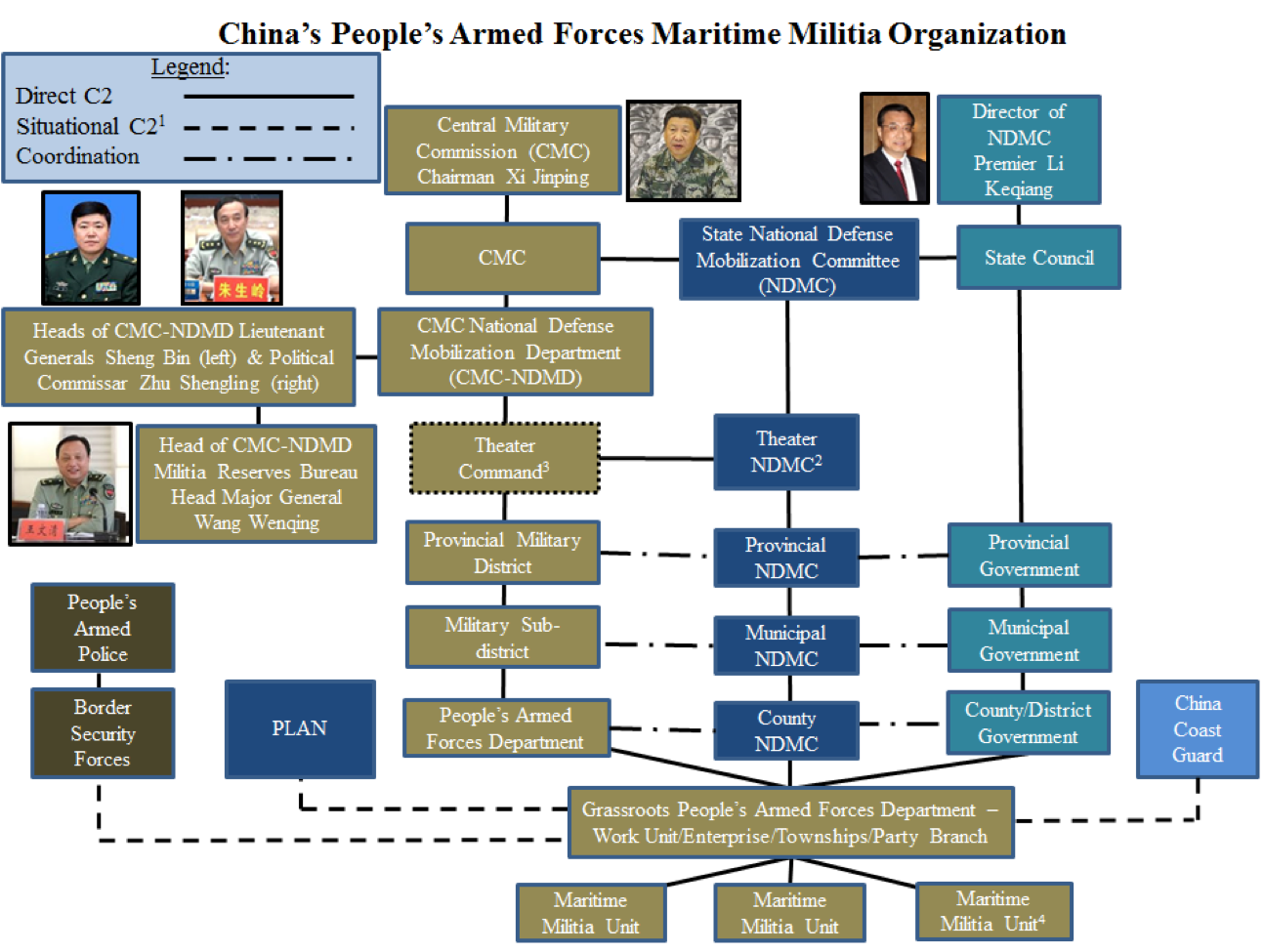
Notes for Figure 1 (above):
1) Command of the PAFMM depends on the conditions prompting its mobilization in the first place, both in peace and in war. Generally, the MD chain of command exercises command over the PAFMM until operational command is delegated temporarily to the PLAN or CCG.[20] The PAFMM serves the Navy in both peacetime and wartime. MLE forces can also call on PAFMM forces for their own missions, but would likely have to provide compensation for the resources, i.e., fuel and labor, expended in such operations.[21] In their non-activated regular capacity as civilians conducting economic activities such as fishing, PAFMM members also maintain subordinate relationships with administrative entities such as the CCG and the PAP Border Defense Force. In all cases, the MD military and civilian leadership would be involved, either directly or at very least in a supervisory role.
2) National Defense Mobilization Committees (国防动员委员会) are consulting and coordinating bodies that assemble each level of civilian and military leadership under a single decision-making organ. Each level of NDMC works to ensure that national resources can be swiftly incorporated into national emergency or war efforts. Following recent PLA organizational reforms, it remains unclear whether there is still a NDMC-level entity between MDs and the State/CMC level, heretofore known as the “Military Region NDMC.” Transforming the former Military Regions into Theater Commands was meant to focus theater level commands’ efforts on joint warfighting rather than on the administrative functions of preparation for mobilization. The lack of Chinese reporting makes verification of this issue particularly difficult. Not reflected in the above organization chart, but also relevant to PAFMM building, are the Border and Coastal Defense Committees (边海防委员会) established in coastal provinces. As with the NDMCs, there is a State Border and Coastal Defense Committee under the unified leadership of the CMC and State Council, as well as Border and Coastal Defense Committees established at each corresponding level of governments and military commands in the provinces. These committees are also consulting and coordinating bodies for implementing defense of China’s land borders and claimed territorial waters, coordinating military and civilian forces under a single decision-making body. It also remains unknown if there will be a Border and Coastal Defense Committee at the former Military Region level, i.e., in the new Theater Commands.
3) Following the latest reforms, former Military Regions have been relieved of their responsibility for the construction of reserve forces in the provinces. MDs are now under the management of the CMC National Defense Mobilization Department. In times of emergency or war, Theater Commands would likely assume a commanding role for militia forces operating within their areas of geographic responsibility.
4) The depiction of three PAFMM units does not represent any specific order of battle or organizational structure, but rather illustrates that multiple Maritime Militia units may exist under an individual PAFD.
Nature of PLA Control in Specific Incidents
While not all PAFMM activities at sea are directly controlled by the PLA in real time, the ones of greatest concern to the United States and its allies and security partners are PLA-affiliated. A PLA-mandated approval process for mobilizing the PAFMM is always involved in events that include its use. Due to the dual-responsibility system, local governments are often involved in providing leadership over PAFMM forces when they are mobilized. Depending on the type of missions assigned, local governments and government agencies will both assume relevant roles to facilitate the missions of the PAFMM, thereby ensuring “unified leadership” (统一领导) between the local military and government organs.
Critically, deliberate participation by PAFMM forces in international sea incidents occurs directly under the PLA chain of command, at least in a supervisory capacity. Moreover, some leading elements of the PAFMM appear to be increasingly professionalized and militarized; the most advanced among them may draw a generous salary with no fishing or other civil economic employment whatsoever.[xxii] This trend would certainly make management and training of the PAFMM easier for PLA authorities. Increasingly capable PAFMM forces may also be bolstered by the continued downsizing of the PLA Army as veterans comprise priority recruitment by MDs. Although the following examples are from the South China Sea, abundant evidence indicates that similar control structures are present in the MDs in coastal provinces bordering the East China Sea and the Yellow Sea.
Activities are also initiated by non-PLA organs, albeit with PLA approval, in a general supervisory role attentive to the condition of units and their vessels. These include basic recurrent peacetime tasks such as fishing, typhoon response and other disaster relief organized by local governments, search and rescue missions to assist the CCG, presence missions in disputed waters, and the expulsion of foreign fishermen from Chinese-claimed waters. Examples of non-recurrent assignments not known to involve PLA initiation include the following. In March 2009 Sanya’s Maritime Militia participated in the harassment of the USNS Impeccable. In March 2014, it participated in the search for missing Malaysian Airlines Flight 370, likely within the confines of the South China Sea. In April 2013 Sanya’s Maritime Militia protected China National Offshore Oil Corporation (CNOOC)’s surveying operations south of Triton Island.
The harassment of the USNS Impeccable is a fitting example. Fisheries Law Enforcement (FLE) under the direction of FLE South China Sea Bureau Director Wu Zhuang commanded the fishing vessels that impeded the U.S. survey vessel’s operations.[xxiii] Having established a PAFMM unit in 2009,[xxiv] the Sanya Fugang Fisheries Company grassroots PAFD would thus have requested mission approval from its superiors in the district or municipal PAFDs in Sanya City, notifying their PLA superiors at a minimum. The degree to which the PLA was involved in harassment of the USNS Impeccable is still unclear; at least one PLAN vessel was on the scene. However, the fact that the Sanya fishing vessels involved were in the PAFMM would necessitate PLA awareness of FLE intentions regarding the incident.
PAFMM activities documented to have been initiated and guided by PLA organs include direct participation in the following international sea incidents pre-planned by China: the 1974 seizure of the Western Paracels from Vietnam, reconnaissance and sovereignty patrols during the February 2014 blockade of Second Thomas Shoal, and the 2014 repulsion of Vietnamese vessels from disputed waters surrounding the CNOOC HYSY-981 oil rig.
The 2012 Scarborough Shoal Standoff shows how the PLA can mobilize militia forces already at sea. Available sources do not reveal a direct PLA connection to the initial PAFMM-related encounters that sparked the April 2012 Scarborough Shoal Standoff. However, reports on members of the PAFMM unit present and their actions at Scarborough Shoal suggest PLA involvement in subsequent command and control of PAFMM operations to help seize the feature from the Philippines.
When Philippine naval forces arrived at Scarborough Shoal on 10 April 2012, Chinese militiamen from the Port of Tanmen in Hainan Province provided their first reports to a Border Defense Force Control Station located in their home port, which in turn alerted a civilian law enforcement agency (China Marine Surveillance, now part of the CCG) to come to their aid. PAFMM-produced reporting on events at sea is shared among the local military commands, PLAN, and CCG; the Tanmen Maritime Militia alone is credited with providing 510 pieces of “valuable intelligence” in recent years.[xxv] Among the six Tanmen fishing vessels initially inside Scarborough Shoal’s lagoon, two were commanded by known Tanmen Maritime Militia squad leaders Chen Zebo and Xu Detan. The owner of fishing vessel Qionghai 02096 and likely a militia member, Yu Ning, transmitted several messages that alerted the PAP Border Defense Control Station of the unfolding situation and the identity of the approaching Philippine naval vessel BRP Gregorio del Pilar. The station’s attendant then rapidly issued a quick brief that was probably shared with PLAN and MLE forces.[xxvi] While the Tanmen Militia contingent was escorted away after the initial standoff by MLE vessels, their subsequent mobilization and return to the vicinity of the shoal under the company’s deputy commander, who then led the unit from outside the shoal, suggests PLA approval of such mobilization.
The PLA communicates with PAFMM vessels at sea by using a communications suite required by the MD Command to be present aboard all militia vessels. Moreover, to join the PAFMM, a Chinese fishing vessel or enterprise must meet certain capability and reliability requirements before gaining membership; many are thus ineligible. Vessels are inspected to ensure they have the onboard equipment[xxvii] to stay connected to the PAFD and can respond wherever they are located. This is central to the ISR reporting of the PAFMM, a persistent function that occurs regularly and independently outside of missions and training.[xxviii] While exact reporting protocol varies, it appears that PAFMM reporting follows the same channels that their mobilization orders originate from, the MD Command system and their PAFDs, which subsequently is shared with other agencies. During PAFMM personnel training, PAFDs provide specialized training to “information personnel” in target identification and reporting protocol. MLE forces are also involved in these information-sharing channels, but direct PAFMM to MLE vessel reporting requirements remain unclear or perhaps temporary or conditional.[xxix] Nonetheless, PAFMM forces make regular contributions to China’s maritime domain awareness, regardless of mobilization status.
Key Actors: The Leading Units
The PAFMM organizational structure resembles an enormous pyramid with a broad base. The vast majority of the thousands of Maritime Militia personnel and vessels handle relatively mundane tasks, such as supporting basic port security, in undisputed shoreline areas of no direct concern to foreign nations or navies.[xxx] An elite subset is entrusted with operating far from Mainland China’s coastline and monitoring, approaching, and engaging with other foreign sea actors as necessary, including in international sea incidents. This is evident in both articles authored by PLA leaders and actual unit construction.[xxxi]
These advanced units can be defined specifically because they are distinctive and few. They are the frontline irregular forces that the United States and its allies and partners will most likely encounter in the Near Seas (Yellow, East China, and South China Seas). With respect to the South China Sea, most known leading units are based in Hainan Province, which according to Chinese policy statements administers the vast majority of the South China Sea. Four major PAFMM units dominate Hainan’s Maritime Militia operations in the South China Sea. The Danzhou Militia, still active and developing today, is the successor to the militia company that played an important role in the 1974 Battle of the Paracel Islands wherein China wrested the Western Paracels from Vietnam. The Tanmen Militia, established in 1985, supported early first-generation-structure construction on such Chinese-occupied Spratly features as Mischief Reef in the 1990s and more recently played a key role in China’s 2012 takeover of Scarborough Shoal. President Xi Jinping visited the Tanmen Militia in April 2013. Sanya City’s Maritime Militia had a frontline role in disrupting USNS Impeccable’s operations in March 2009. Maritime Militia units from across Hainan Province, including key units from Sanya and Tanmen, participated in the two-month-long incident over an oil rig placed inside Vietnam’s claimed EEZ in 2014.[xxxii] The latest leading unit is the Sansha City Maritime Militia headquartered on the Paracels’ Woody Island, a prefectural-level city responsible for administering China’s South China Sea claims, including in the Paracels, Macclesfield Bank and Scarborough Shoal, and the Spratlys.
In Sansha, China is generating a new model for PAFMM development. The militia in the Sansha City Fisheries Development Company was established to be a professional paramilitary force first and foremost, with fishing a secondary mission at best. Sansha Maritime Militia members have been photographed loading crates labeled “light weapons” onto one of their several dozen newly delivered large vessels, all of which boast mast-mounted water cannons, collision-absorbing rails, and reinforced hulls—highly useful features for aggressive spraying and ramming. The largest Sansha Maritime Militia vessels are 59 meters long with 9 meters beam, and likely displace approximately 750 tons. Their smaller counterparts are likely closer to 600 tons.[xxxiii] All have considerable displacement and are longer than the Parola-class patrol vessels Japan is constructing for the Philippines.[xxxiv] Some of these new ships reportedly have a “weapons and equipment room” and an “ammunition store.”[xxxv]
Sansha is taking the blue hull role in China’s three-tier Navy-MLE-Maritime Militia “joint defense” to a new level of frontline capability, centered on a $6 million command center. This force also operates “informatized” outposts on at least two Paracel Islands that monitor proximal seas. PLA leaders have indicated that these initial outposts will be replicated in the Spratlys, and have begun construction on three other features in the Paracels. Already, the Sansha Garrison has established a PAFD on Fiery Cross Reef and a PAFMM element on Mischief Reef, foreshadowing a future permanent PAFMM presence in the Spratlys.
APPENDIX 1: PHOTOS
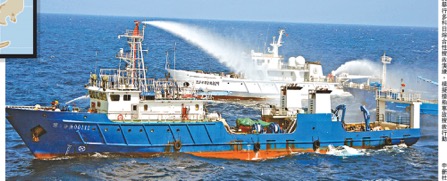
Ta Kung Pao, 14 July 2016: One of Sansha City’s newly-built PAFMM fishing vessels, “Qiongsanshayu 00111” (琼三沙渔), participates in the “2016 Sansha Maritime Emergency Response Exercise” hosted by the Hainan Maritime Safety Administration. Shown in this photo conducting firefighting and rescue operations, this is one example of the new elite PAFMM forces’ vessels under construction for Sansha City.
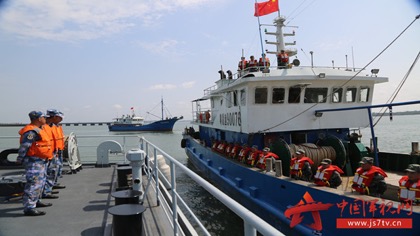
China Military Online, 24 September 2016: (Guangdong Province) Zhanjiang Maritime Militia come alongside a PLAN vessel for training. The appearance of these fishing vessels is typical of regular PRC fishing vessels.
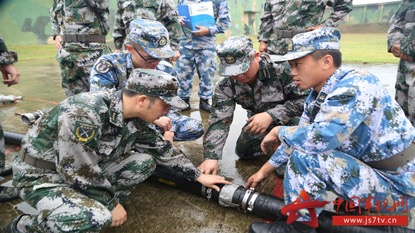
China Military Online, 24 September 2016: (Guangdong Province) Zhanjiang Maritime Militia shown conducting Petroleum, Oil, and Lubricants (POL) resupply training with the PLAN wearing clearly marked green uniforms. Collar insignia reads “GDMB” (“Guangdong Minbing”). Most militia uniforms only feature the letters “MB” on collar insignia without additional geographic designator abbreviations.
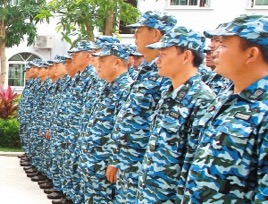
Hainan Daily, 5 January 2015: (Hainan Province) Tanmen Maritime Militia are assembled wearing a different style of uniform. The Tanmen Maritime Militia have also appeared wearing the army-style green camouflage uniforms shown in the previous photo of the Zhanjiang Maritime Militia.
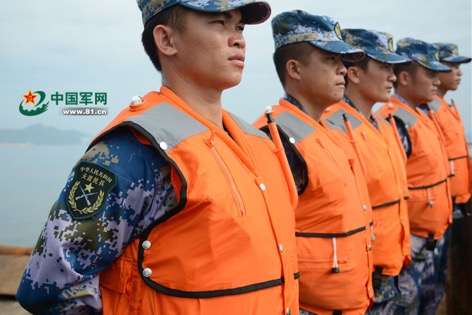
China Military Online, 23 July 2016: A PLAN South Sea Fleet base, most likely the Yulin Navy Base given its mobilization of Sanya City’s Maritime Militia in this instance, held a joint defense exercise including PLAN ships, submarines, aircraft, shore-based guided missiles, special forces, and public security forces; as well as both land-based militia and the Maritime Militia. This photo shows a Maritime Militia unit from Sanya City’s Tianya district participating in the exercise, wearing blue uniforms clearly indicating their identity as “Tianya Militia” (天涯民兵) on the shoulder patch.
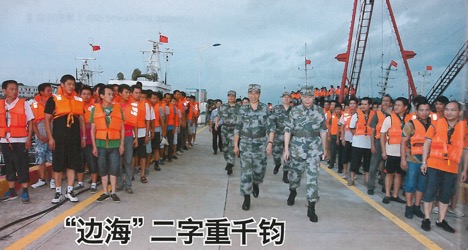
The November 2016 issue of China’s Militia covering the Guangxi Zhuang Autonomous Region’s border and coastal defense work featured this image of non-uniformed PAFMM personnel during inspection. The article also described one of the militia’s requisite characteristics as: “putting on military uniforms [they] qualify as soldiers, taking off the uniforms they qualify as citizens” (穿上军装做合格战士, 脱下军装做合格公民).[xxxvi]
APPENDIX 2: BIBLIOGRAPHY OF AUTHORS’ PUBLISHED RESEARCH
Andrew S. Erickson, “Passing a Chinese Maritime ‘Trump Test’,” The National Interest, 15 December 2016, http://nationalinterest.org/feature/passing-chinese-maritime-trump-test-18754.
Andrew S. Erickson, “The South China Sea’s Third Force: Understanding and Countering China’s Maritime Militia,” Testimony before the House Armed Services Committee Seapower and Projection Forces Subcommittee, Hearing on Seapower and Projection Forces in the South China Sea, Washington, DC, 21 September 2016, http://docs.house.gov/meetings/AS/AS28/20160921/105309/HHRG-114-AS28-Wstate-EricksonPhDA-20160921.pdf.
Conor M. Kennedy and Andrew S. Erickson, “Riding a New Wave of Professionalism and Militarization: Sansha City’s Maritime Militia,” Center for International Maritime Security (CIMSEC), 1 September 2016, http://cimsec.org/riding-new-wave-professionalization-militarization-sansha-citys-maritime-militia/27689.
Andrew S. Erickson and Conor M. Kennedy, “Countering China’s Third Sea Force: Unmask Maritime Militia before They’re Used Again,” The National Interest, 6 July 2016, http://nationalinterest.org/feature/countering-chinas-third-sea-force-unmask-maritime-militia-16860.
Andrew S. Erickson and Conor M. Kennedy, “Chapter 5: China’s Maritime Militia,” in Rear Admiral Michael McDevitt, USN (ret.), ed., Becoming a Great “Maritime Power”: A Chinese Dream (Arlington, VA: CNA Corporation, June 2016), 62-83, https://www.cna.org/CNA_files/PDF/IRM-2016-U-013646.pdf.
Andrew S. Erickson and Conor M. Kennedy, “China’s Maritime Militia: What It Is and How to Deal with It,” Foreign Affairs, 23 June 2016, https://www.foreignaffairs.com/articles/china/2016-06-23/chinasmaritime-militia.
Conor M. Kennedy and Andrew S. Erickson, “From Frontier to Frontline: Tanmen Maritime Militia’s Leading Role—Part 2,” CIMSEC, 17 May 2016, http://cimsec.org/frontier-frontline-tanmen-maritime-militias-leading-role-pt-2/25260.
Conor M. Kennedy and Andrew S. Erickson, “Model Maritime Militia: Tanmen’s Leading Role in the 2012 Scarborough Shoal Incident,” CIMSEC, 26 April 2016, http://cimsec.org/model-maritime-militia-tanmens-leading-role-april-2012-scarborough-shoal-incident/24573.
Andrew S. Erickson and Conor M. Kennedy, “China’s Maritime Militia,” CNA Corporation, 7 March 2016, https://www.cna.org/cna_files/pdf/Chinas-Maritime-Militia.pdf.
Andrew S. Erickson and Conor M. Kennedy, “Trailblazers in Warfighting: The Maritime Militia of Danzhou,” CIMSEC, 1 February 2016, http://cimsec.org/trailblazers-warfighting-maritime-militia-danzhou/21475.
Andrew S. Erickson and Conor M. Kennedy, “China’s Daring Vanguard: Introducing Sanya City’s Maritime Militia,” CIMSEC, 5 November 2015, http://cimsec.org/chinas-daring-vanguard-introducing-sanya-citys-maritime-militia/19753.
Andrew S. Erickson and Conor M. Kennedy, “Irregular Forces at Sea: Not ‘Merely Fishermen’—Shedding Light on China’s Maritime Militia,” CIMSEC, 2 November 2015, http://cimsec.org/new-cimsec-series-on-irregular-forces-at-sea-not-merely-fishermen-shedding-light-on-chinas-maritime-militia/19624.
Andrew S. Erickson, “Making Waves in the South China Sea,” A ChinaFile Conversation, The Asia Society, 30 October 2015, http://www.chinafile.com/conversation/making-waves-south-china-sea.
Andrew S. Erickson and Conor M. Kennedy, “Directing China’s ‘Little Blue Men’: Uncovering the Maritime Militia Command Structure,” Asia Maritime Transparency Initiative, Center for Strategic and International Studies, 11 September 2015, https://amti.csis.org/directing-chinas-little-blue-men-uncovering-the-maritime-militia-command-structure/.
Andrew S. Erickson and Conor M. Kennedy, “Tanmen Militia: China’s ‘Maritime Rights Protection’ Vanguard,” The National Interest, 6 May 2015, http://nationalinterest.org/feature/tanmen-militia-china%E2%80%99s-maritime-rights-protection-vanguard-12816.
Andrew S. Erickson and Conor M. Kennedy, “China’s Island Builders: The People’s War at Sea,” Foreign Affairs, 9 April 2015, https://www.foreignaffairs.com/articles/east-asia/2015-04-09/china-s-island-builders.
Andrew S. Erickson and Conor M. Kennedy, “Meet the Chinese Maritime Militia Waging a ‘People’s War at Sea’,” China Real Time Report (中国实时报), Wall Street Journal, 31 March 2015, http://blogs.wsj.com/chinarealtime/2015/03/31/meet-the-chinese-maritime-militia-waging-a-peoples-war-at-sea/.
Notes:
[1] The views expressed here are the authors’ alone. They do not represent the estimates or policies of the U.S. Navy or any other organization of the U.S. government. A complete compilation of the authors’ analysis, together with related sources and data, is available at: http://www.andrewerickson.com/2017/03/china-open-source-example-shipyard-details-sansha-maritime-militia-vessel-with-weapons-and-equipment-room-and-ammunition-store/.
[2] “中国武装力量的多样化运用” [The Diversified Employment of China’s Armed Forces], Information Office of the State Council, People’s Republic of China, 2013, http://www.mod.gov.cn/affair/2013-04/16/content_4442839.htm.
[3] China’s “People’s Armed Forces System” is comprised of three bodies of personnel: the civilian People’s Armed Forces Cadres that man the grassroots PAFDs, the staff of grassroots PAFDs—usually veterans, and the militia.
[4] While exact numbers are difficult to calculate from open sources, a rough estimate within an order of magnitude can be established by sifting through reports on PAFMM units in the provinces. The scale and effective strength of a province’s PAFMM force are directly determined by its local conditions, such as the dynamism of its marine economy. The authors’ research on Hainan Province has identified 31 PAFMM units, all of which would be considered fendui (分队) or tactical-level-unit organizations (battalion, company, platoon, squad). While most counties establish at least one company-sized PAFMM unit, their size and capabilities vary tremendously. For example, some units can conduct missions in the Spratlys with their large-tonnage seagoing vessels while others stay in close to shore with their smaller, less capable vessels. Some specialized support units may not even possess vessels organic to their unit and must requisition them when training or conducting missions. In addition to the 31 units the authors have identified, there are also many other smaller militia elements on Hainan Island and stationed at outposts and PRC-occupied features in the South China Sea. One can notionally estimate the total number of personnel and vessels in Hainan’s PAFMM force by assuming that the 31 units are each the rough median size of a PAFMM company (approximately 120 personnel and 10 fishing vessels). This would yield a hypothetical total of 3,720 personnel and 310 vessels.
[5] “国防后备力量” [National Defense Reserve Force], Jinhu County People’s Government Double-Support Office, 20 October 2016, http://www.jinhu.gov.cn/art/2016/10/20/art_96_19469.html.
[6] Local military commands here refer to the levels of organization set up by the PLA in province-level administrative areas, forming what China terms “local military and government” (地方军地). Each military region (军区), recently reformed from 7 Military Regions into 5 Theater Commands (战区), contains several provinces and hence several Provincial Military Districts (省军区). The geographic area of responsibility by each Provincial Military District coincides with the borders of the provincial administrative area. As each province is divided into municipalities, each Provincial Military District is divided into multiple Military Subdistricts (军分区); within each Military Subdistrict are numerous county-level and grassroots People’s Armed Forces Departments. The county level PAFDs are staffed by active-duty personnel while the grassroots PAFDs are non-active duty organizations staffed by “full-time People’s Armed Forces cadres” (专职人民武装干部). The Provincial Military Districts oversee local PLA units and the reserves (both PLA reserves and PAF militia), including the militia work conducted by their subordinate Military Subdistricts and PAFDs within its area of responsibility. Each corresponding level of government in the provinces also shares responsibility for coordinating with their military counterparts, the equivalent level of local military command, to build and support the militia. This civilian-military division of responsibilities mitigates the costs and burdens of militia building on any single department.
[7] Like the PLA, militia units have Party organizations to implement the PLA’s political work. For example, militia companies have a Party branch with a political instructor. Platoons and squads also form Party Small Groups. Party members often become leading cadres in militia units. Party representation ensures Party control of the gun at the micro-levels of militia organization.
[8] Local governments can also make use of their administrative authorities to ensure smooth execution of PAFMM missions and training, as well as coordination among different bureaucracies (Maritime Safety Administration, CCG, etc.) when drafting emergency response plans that may entail mobilization of the militia. Local military commands also work with civilian governments to legislate rules and regulations for the use of PAFMM forces. This dual-responsibility system between local military and government authorities enables deeper civil-military integration and resource sharing in militia construction.
[9] 张践 [Zhang Jian], “围绕 ‘六化’ 抓建 推动海上民兵转型” [Advance the Transformation of Maritime Militia Centered on ‘Six Changes’], National Defense 10 (2015), http://kns55.en.eastview.com/kcms/detail/detail.aspx?recid=&FileName=GUOF201510009&DbName=CJFD2015&DbCode=CJFD; “钦州军分区着力提升实战能力 – 联训联演建强海上民兵” [The Qinzhou Military Subdistrict Strives to Enhance Combat Capability – Joint Exercises Strengthen the Maritime Militia], China Defense News, 15 July 2015, http://www.mod.gov.cn/power/2015-07/15/content_4601890.htm.
[10] To build the militia, the PLA receives direct allocations from central and provincial governments, and is required to submit budgets and reports for approval by government authorities. The PLA manages those funds internally through its chain of logistics departments. In addition, local governments compensate militia personnel directly for wages lost while participating in training. PAFMM costs introduce greater complexity in funding and compensation since elements of the force assist and receive support from multiple bureaucracies, such as MLE forces. Some sources suggest that whoever uses PAFMM units must provide a degree of support for those operations (谁用兵谁保障), implying that CCG may have to provide funding and material support to PAFMM units that it uses. As reflected in the dual-responsibility system of military and civilian leaders over the militia, military and civilian cooperation is required to fund the militia.
[11] Most county PAFDs are regimental grade organizations within the PLA grade structure, while PAFDs established in sub-provincial cities and their districts are deputy divisional grade organizations.
[12] “三沙市推动军警民联防机制 构建三线海上维权格局” [Sansha City Advances its Joint Military, MLE, Militia Defense System—Constructs a Three-line Maritime Rights Protection Layout], China News Online, 22 November 2014, http://www.chinanews.com/gn/2014/11-21/6803776.shtml; Interview with PLA Major General Liu Lianhua: “军队代表: 应从战略层面构建军警民海防体系” [Military Representative: [We] Should Strategically Construct a Military, Police, Militia Maritime Defense System], China News Online, 15 March 2013, http://www.chinacourt.org/article/detail/2013/03/id/922031.shtml.
[13] While a variety of militia uniforms can be observed in photos of militia training and assembly, there is no standard uniform for China’s militia forces. Militia uniforms often feature an insignia on the collar with two parallel lines interspersed with the letters “MB,” an abbreviation of the Chinese word for militia, “minbing.” Identification of PAFMM personnel is particularly difficult as they typically wear no uniforms while conducting operations at sea, thereby exploiting perceived advantages in their role as both military personnel and citizen marine workers.
[14] 刘卫华 [Liu Weihua], “军种主建, 民兵专业分队如何对接?” [Services Focus on Building, How Do Militia Specialized Detachments Correspond?], China Defense News, 27 January 2016, http://www.81.cn/mb/2016-01/27/content_7071697.htm; 吴维满 [Wu Weiman], “中国新型军兵种民兵分队上演兵场, 适应作战需要” [China’s New-type Service Militia Detachments Fielded as Soldiers, Adapting to Operational Requirements], PLA Daily, 27 December 2010, http://mil.sohu.com/20101227/n278525284.shtml.
[15] 郑一冰、钱晓虎 [Zheng Yibing and Qian Xiaohu], “后备新军: 万里海疆试锋刃- 我国海军民兵专业分队扫描” [New Reserve Forces: Testing the Vanguard of the Vast Maritime Frontier—A Review of China’s Naval Militia Specialized Detachments], China’s Militia 4 (2007), http://kns55.en.eastview.com/kcms/detail/detail.aspx?recid=&FileName=MMZG200704042&DbName=cjfd2007&DbCode=CJFD.
[16] Chinese sources express this in variations of a similar phrase, such as “putting on camouflage they qualify as soldiers, taking off camouflage they are law abiding fishermen” (穿上迷彩是合格战士, 脱下迷彩是守法渔民). “广西北海军分区加强海上民兵建设 提升装备效能” [Beihai Military Subdistrict of Guangxi Strengthens Maritime Militia Construction, Increases Equipment Performance], PLA Daily, 6 January 2014, http://www.chinanews.com/mil/2014/01-06/5700496.shtml.
[17] “科学构建海上民兵管控体系” [Scientifically Construct a Management System for the Maritime Militia], National Defense 12 (2014), http://kns55.en.eastview.com/kcms/detail/detail.aspx?recid=&FileName=GUOF201412038&DbName=CJFD2014&DbCode=CJFD.
[18] 郑陵晨 [Zheng Lingchen], “发挥好海上民兵优势 打好军民融合攻坚战” [Make Full Use of the Advantages of the Maritime Militia and Fight a Tough Battle in Civil-Military Fusion], China Navy News, 31 October 2016, http://navy.81.cn/content/2016-10/31/content_7334774.htm.
[19] The “Three Warfares” refers to the use of public opinion warfare, psychological warfare, and legal warfare to assert influence in support China’s national objectives. For more information, see Elsa Kania, “The PLA’s Latest Strategic Thinking on the Three Warfares,” Jamestown: China Brief 16.13 (22 August 2016), https://jamestown.org/program/the-plas-latest-strategic-thinking-on-the-three-warfares/; 郑凌晨 [Zheng Lingchen], “发挥好海上民兵优势 – 打好军民融合攻坚战” [Give Full Play to the Advantages of the Maritime Militia – Fighting a Civilian-Military Integrated Battle], China Navy Online, 31 October 2016, http://navy.81.cn/content/2016-10/31/content_7334774.htm.
[20] 徐海峰 [Xu Haifeng], “适应新形势 全面规范海上民兵建设 ” [Adapting to New Circumstances— Comprehensively Standardize Maritime Militia Construction], National Defense, No. 2 (2014), http://kns55.en.eastview.com/kcms/detail/detail.aspx?recid=&FileName=GUOF201402048&DbName=CJFD2014&DbCode=CJFD.
[21] Ibid.
[xxii] This report draws heavily on the authors’ research on PAFMM from Hainan Province operating in the South China Sea, which has identified and evaluated a variety of PAFMM units province-wide. They have identified an elite subset of units greater in capability and readiness than the bulk of other units; as well as recruiting preferences for more experienced mariners and PLA veterans, particularly in the Sansha City Maritime Militia.
[xxiii] Ryan D. Martinson, “From Words to Action: The Creation of the China Coast Guard,” CNA Corporation, 29 July 2015, 20, https://www.cna.org/cna_files/pdf/creation-china-coast-guard.pdf; “中国渔政 蓝色国土的守护者” [China’s Fisheries Law Enforcement—Protectors of the Nation’s Blue Territory], Lianjiang City Oceanic and Fisheries Administration Information Network, 22 February 2011, http://www.ljhyj.gov.cn/Shownews.asp?Sid=79.
[xxiv] “林同兴与林心瑞与魏立凤与三亚福港实业有限公司单位行贿罪刑事二审裁定书” [Appeal Ruling on the Lin Tongxing, Lin Xinrui, Wei Lifeng, and Sanya Fugang Fisheries Co. Ltd. Bribery Case], Hainan Province Haikou Municipal Intermediate People’s Court, 28 December 2015, http://openlaw.cn/judgement/4386f3505aaf46988c35dca2097d1b60.
[xxv] 王春棠 [Wang Chuntang], “渔民保护神: 海南潭门海上民兵连守护南海29年” [Protectors of the Fishermen: The Hainan Tanmen Maritime Militia Company Guards the South China Sea for 29 Years], Business Daily of International Tourism Island, 6 January 2014, http://sansha.hinews.cn/system/2014/01/06/016357550.shtml.
[xxvi] This dynamic was expressed in 2007 by authors from the PLAN HQ Military Affairs Department and resulted in PAFMM unit construction in Zhejiang Province. “依托海上民船民兵建立侦察信息体系” [Establish a Reconnaissance System Based on Civilian Vessels and Militia], National Defense 6, 2007, http://kns55.en.eastview.com/kcms/detail/detail.aspx?recid=&FileName=GUOF200706034&DbName=cjfd2007&DbCode=CJFD; “浙江省宁波市国动委加强海上动员力量建设记事” [Chronicle of Zhejiang Province, Ningbo City’s National Defense Mobilization Committee Strengthening Construction of Maritime Mobilization Forces], National Defense News, 25 May 2015, http://www.mod.gov.cn/mobilize/2015-05/25/content_4586486.htm; 徐海峰 [Xu Haifeng], “适应新形势 全面规范海上民兵建设” [Adapting to New Circumstances— Comprehensively Standardize Maritime Militia Construction], National Defense, No. 2 (2014), http://kns55.en.eastview.com/kcms/detail/detail.aspx?recid=&FileName=GUOF201402048&DbName=CJFD2014&DbCode=CJFD.
[xxvii] Communications equipment central to fisheries management as well as command of the PAFMM includes China’s indigenous Beidou satellite navigation system, which features transmission capability of 120 Chinese characters per message, conveying significant content thanks to Chinese characters’ unique logographic nature.
[xxviii] 廖刚斌, 王牌, 熊睿 [Liao Gangbin, Wang Pai, and Xiong Rui], “海上民兵分队建设存在的问题与对策” [Issues and Measures in Maritime Militia Unit Construction], National Defense 8 (2014), http://kns55.en.eastview.com/kcms/detail/detail.aspx?recid=&FileName=GUOF201408006&DbName=CJFD2014&DbCode=CJFD; “Scientifically Construct a Management System for the Maritime Militia], National Defense 12 (2014); 徐海峰 [Xu Haifeng], “适应新形势 全面规范海上民兵建设” [Adapting to New Circumstances— Comprehensively Standardize Maritime Militia Construction], National Defense, No. 2 (2014), http://kns55.en.eastview.com/kcms/detail/detail.aspx?recid=&FileName=GUOF201402048&DbName=CJFD2014&DbCode=CJFD.
[xxix] 徐海峰 [Xu Haifeng], “适应新形势 全面规范海上民兵建设” [Adapting to New Circumstances— Comprehensively Standardize Maritime Militia Construction], National Defense, No. 2 (2014), http://kns55.en.eastview.com/kcms/detail/detail.aspx?recid=&FileName=GUOF201402048&DbName=CJFD2014&DbCode=CJFD; “浙江省加强海上民兵建设” [Zhejiang Province Strengthens Maritime Militia Construction], Xinhua Wang, 4 December 2013, http://news.xinhuanet.com/mil/2013-12/04/c_125806747.htm; 徐海峰 [Xu Haifeng], “适应新形势 全面规范海上民兵建设” [Adapting to New Circumstances— Comprehensively Standardize Maritime Militia Construction], National Defense, No. 2 (2014), http://kns55.en.eastview.com/kcms/detail/detail.aspx?recid=&FileName=GUOF201402048&DbName=CJFD2014&DbCode=CJFD; “福安市人武部组织海上民兵信息员集训” [Fu’an City PAFD Organizes Maritime Militia Information Personnel Collective Training], Fujian National Defense Education Network, 19 September 2014, http://mil.fjsen.com/2014-09/19/content_14905500.htm.
[xxx] Among the issues beyond this report’s scope is the great diversity of unit types and functions in militia forces, even within the PAFMM alone. Due to limited capabilities and training resources, many PAFMM units are given a narrow set of mission tasks on which to focus, often in line with their civilian professional specialties, such as transport, medical rescue, supply, and reconnaissance. This division of labor and functional specialization increases the utility of individual units. As mentioned earlier, militia unit sizes are largely restricted to tactical-levels of organization usually employing army-style terms, thereby forming “squads,” “platoons,” “companies,” and “battalions.” Most PAFMM units are typically company-sized and similarly use army terms. Some reports, by contrast, refer to PAFMM units using naval-style terminology such as “squadron” (中队).
[xxxi] After becoming head of the CMC National Defense Mobilization Department’s Militia Reserves Bureau in 2016, Major General Wang Wenqing wrote in National Defense News about solutions to solving PAFMM problems, including the construction of an elite effective maritime militia forces for “year-round missions guarding the ocean frontier.” See “破解海上民兵建设难题” [Resolving Issues in Maritime Militia Construction], National Defense News, 28 July 2016, www.81.cn/gfbmap/content/2016-07/28/content_151895.htm. This is also reflected in articles written by Hainan Provincial Military District Commander Zhang Jian and Political Commissar Liu Xin: 张践 [Zhang Jian], “围绕‘六化’抓建 推动海上民兵转型” [Advance Transformation of the Maritime Militia Centered on Six Changes], National Defense 10 (2015), http://kns55.en.eastview.com/kcms/detail/detail.aspx?recid=&FileName=GUOF201510009&DbName=CJFD2015&DbCode=CJFD; 刘新[Liu Xin], “面向复杂多变海洋安全环境, 着力抓好海上民兵维权准备” [Geared Towards a Complex and Volatile Maritime Security Environment—Focus on Preparing Maritime Militia Rights Protection], National Defense 12 (2015), http://kns55.en.eastview.com/kcms/detail/detail.aspx?recid=&FileName=GUOF201512011&DbName=CJFD2015&DbCode=CJFD.
[xxxii] A knowledgeable source has described to one of the authors his experience aboard a Sanya Maritime Militia vessel. He observed substantial “T-bar” type reinforcements inside the hull. Unlike a normal fishing vessel, there was no sight or smell of anything fish-related. Personnel aboard appeared extremely professional and specialized, with a military-style bearing quite different from that of normal fishermen.
[xxxiii] Tonnage estimates were made by: (1) searching for names of known Sansha Maritime Militia at marinetraffic.com, which lists their respective displacement, length, and beam; (2) using these data and estimating draft at no more than 3 meters for vessels in this size category, and (3) employing a block coefficient to calculate displacement.
[xxxiv] Pia Lee-Brago, “Philippines to Get Nine More Patrol Vessels from Japan,” The Philippine Star, 14 October 2016, http://www.philstar.com/headlines/2016/10/14/1633448/philippines-get-9-more-patrol-vessels-japan.
[xxxv] Guangzhou Taicheng Shipbuilding Industry Co. Ltd. (广州市泰诚船舶工业有限公司) provides services for the vessels produced at Xijiang Shipyard in Liuzhou and Huangpu Wenchong Shipyard in Guangzhou, both subsidiaries of China State Shipbuilding Corporation (CSSC). These shipyards have produced a number of the new vessels built specifically for the Sansha Maritime Militia, and have subcontracted additional companies to install subsystems and finish other interior elements of the fleet’s vessels in preparation for delivery. In December 2015, among its advertised services, Taicheng Shipbuilding’s website featured one of the Sansha Maritime Militia vessels that it furnished for the vessel’s producer, Xijiang Shipyard. It is a light trapping vessel capable of employing a falling net to trap squid, a fairly-common commercial design. However, photos contained on the webpage show it to be the vessel Qiongsanshayu 000212; which other open sources reveal to be a ship in the new fleet of Sansha Maritime Militia vessels delivered to the state-run Sansha City Fisheries Development Company that operate under the guise of fishing. Among the numerous details and specifications concerning Qiongsanshayu 000212’s interior furnishing is a listing of two rooms, respectively titled “weapons and equipment room” (武备库) and “ammunition store” (弹药库). Details available in other open sources, some of which show the Sansha Maritime Militia training to load light weapons onto the deck of these new vessels, help confirm the intended roles and identities of this new militia fleet. “2015年12月西江船厂58.5米灯光罩网渔船交船” [Xijiang Shipyard’s 58.5 Meter Light Trap Falling-net Fishing Vessel Delivered in December 2015], Taicheng Shipyard, 12 December 2015. Original URL: http://www.tcship.com/news-show.php?lm=1&id=20. Complete document and accompanying photos now available at: http://www.andrewerickson.com/2017/03/china-open-source-example-shipyard-details-sansha-maritime-militia-vessel-with-weapons-and-equipment-room-and-ammunition-store/.
[xxxvi] “‘边海’二字重千钧” [“Borders and the Sea” Two Very Serious Words], China’s Militia 11 (2016), 30-32.





































